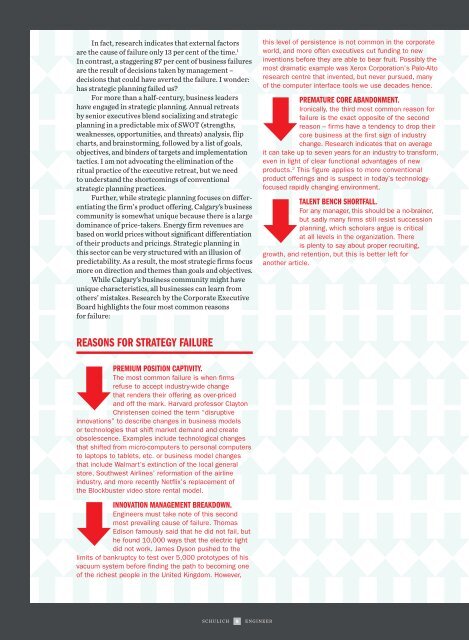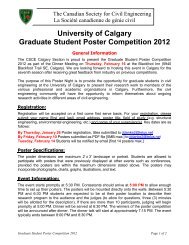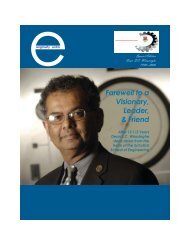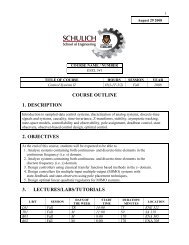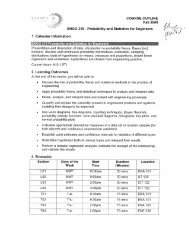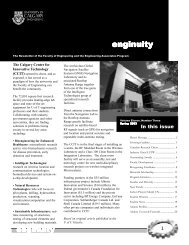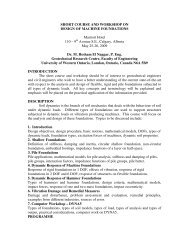11.512 Schulich Fall Rev_Layout 1 - The Schulich School of ...
11.512 Schulich Fall Rev_Layout 1 - The Schulich School of ...
11.512 Schulich Fall Rev_Layout 1 - The Schulich School of ...
- No tags were found...
Create successful ePaper yourself
Turn your PDF publications into a flip-book with our unique Google optimized e-Paper software.
In fact, research indicates that external factorsare the cause <strong>of</strong> failure only 13 per cent <strong>of</strong> the time. 1In contrast, a staggering 87 per cent <strong>of</strong> business failuresare the result <strong>of</strong> decisions taken by management –decisions that could have averted the failure. I wonder:has strategic planning failed us?For more than a half-century, business leadershave engaged in strategic planning. Annual retreatsby senior executives blend socializing and strategicplanning in a predictable mix <strong>of</strong> SWOT (strengths,weaknesses, opportunities, and threats) analysis, flipcharts, and brainstorming, followed by a list <strong>of</strong> goals,objectives, and binders <strong>of</strong> targets and implementationtactics. I am not advocating the elimination <strong>of</strong> theritual practice <strong>of</strong> the executive retreat, but we needto understand the shortcomings <strong>of</strong> conventionalstrategic planning practices.Further, while strategic planning focuses on differentiatingthe firm’s product <strong>of</strong>fering, Calgary’s businesscommunity is somewhat unique because there is a largedominance <strong>of</strong> price-takers. Energy firm revenues arebased on world prices without significant differentiation<strong>of</strong> their products and pricings. Strategic planning inthis sector can be very structured with an illusion <strong>of</strong>predictability. As a result, the most strategic firms focusmore on direction and themes than goals and objectives.While Calgary’s business community might haveunique characteristics, all businesses can learn fromothers’ mistakes. Research by the Corporate ExecutiveBoard highlights the four most common reasonsfor failure:this level <strong>of</strong> persistence is not common in the corporateworld, and more <strong>of</strong>ten executives cut funding to newinventions before they are able to bear fruit. Possibly themost dramatic example was Xerox Corporation’s Palo-Altoresearch centre that invented, but never pursued, many<strong>of</strong> the computer interface tools we use decades hence.PREMATURE CORE ABANDONMENT.Ironically, the third most common reason forfailure is the exact opposite <strong>of</strong> the secondreason – firms have a tendency to drop theircore business at the first sign <strong>of</strong> industrychange. Research indicates that on averageit can take up to seven years for an industry to transform,even in light <strong>of</strong> clear functional advantages <strong>of</strong> newproducts. 2 This figure applies to more conventionalproduct <strong>of</strong>ferings and is suspect in today’s technologyfocusedrapidly changing environment.TALENT BENCH SHORTFALL.For any manager, this should be a no-brainer,but sadly many firms still resist successionplanning, which scholars argue is criticalat all levels in the organization. <strong>The</strong>reis plenty to say about proper recruiting,growth, and retention, but this is better left foranother article.REASONS FOR STRATEGY FAILUREPREMIUM POSITION CAPTIVITY.<strong>The</strong> most common failure is when firmsrefuse to accept industry-wide changethat renders their <strong>of</strong>fering as over-pricedand <strong>of</strong>f the mark. Harvard pr<strong>of</strong>essor ClaytonChristensen coined the term “disruptiveinnovations” to describe changes in business modelsor technologies that shift market demand and createobsolescence. Examples include technological changesthat shifted from micro-computers to personal computersto laptops to tablets, etc. or business model changesthat include Walmart’s extinction <strong>of</strong> the local generalstore, Southwest Airlines’ reformation <strong>of</strong> the airlineindustry, and more recently Netflix’s replacement <strong>of</strong>the Blockbuster video store rental model.INNOVATION MANAGEMENT BREAKDOWN.Engineers must take note <strong>of</strong> this secondmost prevailing cause <strong>of</strong> failure. ThomasEdison famously said that he did not fail, buthe found 10,000 ways that the electric lightdid not work. James Dyson pushed to thelimits <strong>of</strong> bankruptcy to test over 5,000 prototypes <strong>of</strong> hisvacuum system before finding the path to becoming one<strong>of</strong> the richest people in the United Kingdom. However,SCHULICH 8 ENGINEER


